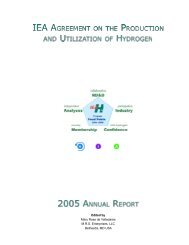Technology Status of Hydrogen Road Vehicles
Technology Status of Hydrogen Road Vehicles
Technology Status of Hydrogen Road Vehicles
Create successful ePaper yourself
Turn your PDF publications into a flip-book with our unique Google optimized e-Paper software.
Appendix 1. Safety Questions <strong>of</strong> <strong>Hydrogen</strong> Storage and Use in <strong>Vehicles</strong><br />
This Appendix shows the available findings on the safety concerns and solutions when hydrogen is stored onboard<br />
and used in road vehicles. Other situations with different safety implications, such as large-scale<br />
stationary hydrogen storage, will not be explicitly handled.<br />
Until operating data are accumulated with hydrogen vehicles, the best approach is to examine the following:<br />
! The fundamental properties <strong>of</strong> hydrogen with safety relevance<br />
! The experience to date from comparable industries (including space)<br />
! Recent simulations <strong>of</strong> specific accidents with H 2 vehicles.<br />
Undoubtedly laymen, and even many technically informed people, react to hydrogen as a particularly<br />
dangerous substance. Yet insiders are becoming ever more convinced that hydrogen has a safety behavior<br />
different, but no worse than, conventional transportation fuels. It is probably safer overall, provided some<br />
basic rules are followed. The public reacts with some skepticism to such affirmations, and great care will be<br />
needed in presenting the situation in a balanced and convincing way. This means paying considerable<br />
attention, when the time comes, to societal concerns as well as to technical aspects.<br />
Much technical work remains to be done to assure even the specialist that hydrogen vehicles can be safely used<br />
by the public. This report concentrates on the technical aspects; however, societal concerns should be factored<br />
rather soon into remaining developments. The reaction provoked by others such as the nuclear industry, which<br />
underrated the need to address legitimate public concerns, should be avoided at all costs.<br />
<strong>Hydrogen</strong> has routinely been used in large quantities for decades in the petroleum refining, chemical, and<br />
petrochemical industries with no serious problems. Moore 1996, summarized in Appendix 4, gives relevant<br />
experience in the USA. The space industry has a similar record, marred only by the Challenger accident<br />
(discussed in section A1.4).<br />
The manner in which safety objectives have been met by these industries is outlined below. This experience<br />
is largely applicable to hydrogen vehicles, but has in this context one important weakness: the public was not<br />
involved, and all procedures were safely in the hands <strong>of</strong> qualified personnel. The safety consciousness typical<br />
<strong>of</strong> such industries can be brought to high levels by training and automatic control, but is difficult to transfer<br />
to the public.<br />
For the foreseeable future, highway driving will be subject to unpredictability, and accidents to confusion and<br />
panic. A new fuel should possess better inherent safety than gasoline or diesel oil. Somewhat paradoxically,<br />
hydrogen has such characteristics, at least to the specialist. A large part <strong>of</strong> the following discussion will<br />
therefore involve comparisons with traditional fuels.<br />
This appendix was written before an important, but unpublished, report (EQHHPP 1993) was made available<br />
after the update was due to the 11th WHEC. Although we could not examine the implications <strong>of</strong> this report<br />
throughout this document, we have been given permission to quote its summary here:<br />
In brief, the study comprises:<br />
! a compilation <strong>of</strong> physical and chemical properties <strong>of</strong> hydrogen<br />
! a description <strong>of</strong> hazards<br />
! a collection <strong>of</strong> international and national rules, discussed in varying depth<br />
! a number <strong>of</strong> recommendations for further development <strong>of</strong> rules and their international harmonization<br />
! proposals for the promotion <strong>of</strong> hydrogen, and the proper approach <strong>of</strong> the public in the early phase <strong>of</strong><br />
industrial projects<br />
! standards and their relevance for selected items <strong>of</strong> the EQHHPP (in the appendixes)<br />
A1.1 Fundamental <strong>Hydrogen</strong> Properties with Safety Relevance<br />
25













